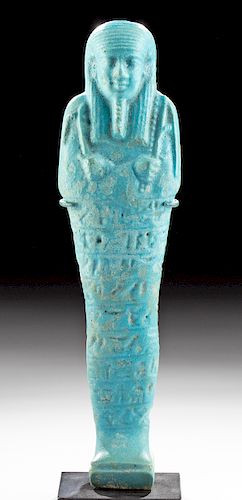Translated Egyptian Glazed Faience Ushabti for Semataui
Lot 13
About Seller
Artemis Fine Arts
686 S Taylor Ave, Ste 106
Louisville, CO 80027
United States
Selling antiquities, ancient and ethnographic art online since 1993, Artemis Gallery specializes in Classical Antiquities (Egyptian, Greek, Roman, Near Eastern), Asian, Pre-Columbian, African / Tribal / Oceanographic art. Our extensive inventory includes pottery, stone, metal, wood, glass and textil...Read more
Categories
Estimate:
$6,000 - $9,000
Absentee vs Live bid
Two ways to bid:
- Leave a max absentee bid and the platform will bid on your behalf up to your maximum bid during the live auction.
- Bid live during the auction and your bids will be submitted real-time to the auctioneer.
Bid Increments
| Price | Bid Increment |
|---|---|
| $0 | $25 |
| $300 | $50 |
| $1,000 | $100 |
| $2,000 | $250 |
| $5,000 | $500 |
| $10,000 | $1,000 |
| $20,000 | $2,500 |
| $50,000 | $5,000 |
| $100,000 | $10,000 |
| $200,000 | $20,000 |
About Auction
By Artemis Fine Arts
Feb 13, 2020
Set Reminder
2020-02-13 10:00:00
2020-02-13 10:00:00
America/New_York
Bidsquare
Bidsquare : Exceptional Antiquities, Asian, Ethnographic
https://www.bidsquare.com/auctions/artemis-gallery/exceptional-antiquities-asian-ethnographic-4848
An important one-day auction featuring museum-worthy examples of Egyptian, Greek, Roman, Etruscan, Near Eastern, Far East / Asian, Pre-Columbian, African / Tribal, Oceanic, Native American, Spanish Colonial, Russian, Fossils, Ancient Jewelry, Fine Art, so much more! Artemis Fine Arts info@artemisfinearts.com
An important one-day auction featuring museum-worthy examples of Egyptian, Greek, Roman, Etruscan, Near Eastern, Far East / Asian, Pre-Columbian, African / Tribal, Oceanic, Native American, Spanish Colonial, Russian, Fossils, Ancient Jewelry, Fine Art, so much more! Artemis Fine Arts info@artemisfinearts.com
- Lot Description
Egypt, Late Dynastic Period, 30th Dynasty, ca. 380 to 343 BCE. A beautiful mold-formed faience ushabti covered in lustrous turquoise-hued glaze. The figure stands in mummiform with fused feet atop an integral rectangular plinth, holds the symbolic pick and hoe in arms crossed atop the chest, and has a seed bag incised behind the left shoulder. The stylized visage exhibits almond-shaped eyes with elongated canthi, a broad nose, full lips with indented corners, cupped ears, and a plaited false beard, all beneath a tripartite wig with lengthy lappets and thin striations. Nine lines of inscribed hieroglyphic text identify this individual as Semataui (also Sema-Taui, Semitaui) - a Sameref priest and commander of Egyptian military troops - that provide him with blessings for his journey through the afterlife. Size: 2" W x 7.5" H (5.1 cm x 19 cm); 7.9" H (20.1 cm) on included custom stand.
This ushabti and many others like it were meant to be placed inside a tomb for the inscribed individual to aid them both in their journey to the afterlife as well as the duties prescribed to them. When translated, this ushabti reads, "The Illuminated, the Osiris, the Sameref priest, commander of the troop, Semataui, son of Sheri, born of Tashepset, justified, he says: O these ushabtis, if counted upon, the Osiris, the Sameref priest, commander of the troop, Semataui, son of Sheri, born of Tashepset, justified, to do all the works that are to be done there in the realm of the dead - now indeed obstacles are implanted there - as a man at his duties, 'here I am!' you shall say when you are counted upon at any time to serve there, to cultivate the fields, to irrigate the river banks, to ferry the sand of the west to the east and vice-versa, 'here I am' you shall say."
This is an interesting ushabti, because the names of the inscribed individuals tell us where Semataui lived. The inscribed names indicate that this individual was from Heracleopolis because his name "Semataui" (Greek Somtous, translated as "he who unifies the two lands") represents a provincial falcon-headed deity who was worshipped in this part of Egypt. The title bestowed to Semataui of "Sameref" (meaning "the son whom he loves") is a priestly title associated with Heracleopolis Magna (Middle Egypt). The name of his father, "Sheri" (meaning "the child"), as well as the name of his mother, "Tasepsetherti" (meaning "the noble one is content"), are also indicative of Middle Egyptian origin.
Provenance: private East Coast, USA collection; ex-Artemis Gallery; ex-private New Jersey, USA collection; ex-William Froelich collection, New York, USA, acquired in the 1970s; ex-Norman Blankman collection, New York, USA, acquired in 1959
All items legal to buy/sell under U.S. Statute covering cultural patrimony Code 2600, CHAPTER 14, and are guaranteed to be as described or your money back.
A Certificate of Authenticity will accompany all winning bids.
We ship worldwide and handle all shipping in-house for your convenience.
#152897Minor nicks and abrasions to base, legs, body, and head, with softening to some finer details and inscribed hieroglyphic characters, light fading to original glaze pigmentation, and some pitting, otherwise intact and excellent. Great traces of original glaze pigment throughout, and most hieroglyphic characters are still legible.Condition
- Shipping Info
-
All shipping is handled in-house for your convenience. Your invoice from Artemis Gallery will include shipping calculation instructions. If in doubt, please inquire BEFORE bidding for estimated shipping costs for individual items.
-
- Buyer's Premium



 EUR
EUR CAD
CAD AUD
AUD GBP
GBP MXN
MXN HKD
HKD CNY
CNY MYR
MYR SEK
SEK SGD
SGD CHF
CHF THB
THB











